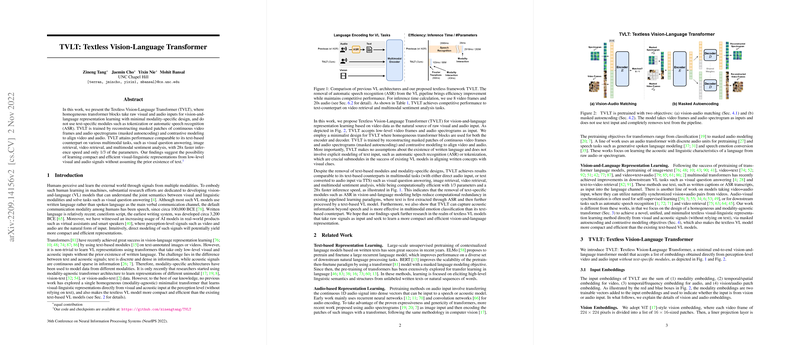Overview of "TVLT: Textless Vision-Language Transformer"
The paper introduces the Textless Vision-Language Transformer (TVLT), a model designed to leverage raw visual and audio inputs for representation learning without the reliance on text-based modules like tokenization or automatic speech recognition (ASR). This approach marks a distinct shift from conventional vision-and-language (VL) models that predominantly use written language as the primary verbal communication channel. TVLT aims to efficiently learn compact visual-linguistic representations directly from low-level signals without assuming the presence of written text.
Core Methodology
TVLT is primarily characterized by its use of a homogeneous transformer architecture that processes vision and audio data in a modality-agnostic manner. Key components include:
- Input Embeddings: TVLT leverages modality, temporal/spatial, and vision/audio patch embeddings. Vision embeddings are inspired by ViT (Vision Transformer) methods, while audio embeddings use spectrograms treated similarly to image patches.
- Encoder-Decoder Structure: The model employs a 12-layer encoder and an 8-layer decoder. Unlike traditional models, the decoder is applied separately to audio and video data, which has shown to enhance performance and efficiency.
- Pretraining Objectives: The model is pretrained using two objectives: masked autoencoding (MAE) for unimodal reconstruction and vision-audio matching (VAM) for cross-modal alignment. These objectives help TVLT learn both joint and separate representations of video and audio data.
Experimental Results and Analysis
TVLT demonstrates performance on par with text-dependent VL models across multiple multimodal benchmarks, including visual question answering, image retrieval, video retrieval, and sentiment analysis. Notably, TVLT achieves these results with a significant reduction in computational load, being 28 times faster in inference speed and requiring only a third of the parameters compared to its text-based counterparts. This efficiency is largely attributed to the elimination of cumbersome ASR processes, which traditionally bottleneck computational resources.
Practical and Theoretical Implications
Practically, TVLT's design provides a framework for deploying more efficient multimodal AI systems, especially where audio and visual cues are inherently available, such as in smart assistants and autonomous systems. Its textless nature poses advantages for non-text-centric applications and environments, aligning closer with how humans naturally perceive and interact—a heralded shift from the historical necessity of text in VL models.
Theoretically, the paper posits that high-quality vision-based models can emerge from raw sensory inputs without pre-processed text, emphasizing the potential universality of transformers when equipped with appropriate objectives. The compactness of the model challenges existing paradigms dictating separate text or modality-specific structures, suggesting new research pathways in the pursuit of more unified, efficient learning architectures.
Future Directions
The authors suggest several avenues for future research, including expanding the model to support more diverse datasets and experimenting with joint and separate encoder-decoder configurations across other modalities. Additionally, the model's apparent efficiency in emotion classification tasks indicates potential for broader affective computing applications that further humanize AI interactions.
While TVLT sets a promising precedent, its broader impact will be shaped by continued exploration of its boundaries and extensions, particularly in a multilingual context or under less standardized environmental conditions where text's ambiguity prevails. As such, ongoing research needs to adapt, refine, and challenge the model beyond the scenarios outlined.
In conclusion, TVLT marks an important step toward scaling multimodal AI learning, embodying a trend that moves away from rigid text-dependencies and towards more innate processing strategies. Its flexibility and efficiency offer new insights and tools for advancing AI's understanding and representation of complex, multimodal interactions without explicit textual intervention.
